
Climbing can be a great workout for upping your cardio and building strength. But the best climbing rope for you largely depends on the specific type of climbing you plan to do. If you're looking to venture into the outdoor climbing world, the rope you'll want will likely be different than a rope specifically made for indoor training, or one that’s intended for big-wall mountaineering adventures.
Climbing ropes are essential safety gear (along with climbing harnesses) that can make the difference between a solid climb or serious injury. Regardless of which rope you decide on, keep in mind that climbing is an inherently dangerous sport. It's important to use the right gear, climbing shoes, and tactics when climbing. We highly recommend learning proper technique and rope management from a guide or experienced climber before venturing out on your own.
That said, there are many different factors to consider when it comes to getting the best rope for your needs. With so many options on the market these days, it can be overwhelming to cut through the noise and determine what rope is best for you. In this guide, we break down all the common details and features that make up climbing ropes, plus our top picks.
Why Trust Us?
ACTIVE.com's editorial team relies on the knowledge and experience of fitness and wellness experts including competitive athletes, climbers, coaches, physical therapists, nutritionists, and certified trainers. This helps us ensure that the products we feature are of the highest standard and have the right features for the activity. Collectively, the team has spent countless hours researching equipment, gear, and recovery tools to create the most accurate, authentic content for our readers. Customer satisfaction is also a key part of our review process, which is why we only feature products that are highly rated. More importantly, each member of our team is a fitness enthusiast. Fitness may be our job, but it is also our passion. Therefore, we strive to bring you products that we trust and would personally use.
The Best Climbing Ropes - Our Top Picks
By clicking on the product links in this article, we may receive a commission fee at no cost to you, the reader. Read full affiliate disclosure here.
- Best Overall Climbing Rope: Edelrid BOA Eco Climbing Rope 9.8mm
- Best Ice and Alpine Rope: Petzl Arial Dry Climbing Rope 9.5mm
- Best Beginner Climbing Rope: Black Diamond Rope 9.9mm
- Best Sport-Climbing Rope: Beal Booster III 9.7mm Dry Rope
- Best Budget Climbing Rope: Mammut Crag Classic Rope 9.5mm
- Best Indoor Climbing Rope: Mammut Gym Workhorse Classic Rope - 9.9mm
What to Look for When Shopping for a Climbing Rope
Type Of Rope
Dynamic
All of the ropes we recommend in this list are dynamic ropes, meaning they have some stretch to them if you fall. For any situation where you may be suddenly applying weight to your rope—pretty much any time you're actively climbing up—you want to have a dynamic rope. This absorbs impact and makes the fall feel more gentle. Exactly how much impact the rope will absorb and how much the rope will stretch varies between ropes.
You'll find those measurements as impact force (how much impact a fall will have on the climber, rope, and belayer), dynamic elongation (how much the rope will stretch from a fall), and static elongation (how much the rope stretches with an 80,000 lb weight attached to it).
Within the dynamic category, you'll find a few other different rope type variations: single, half, and twin.
- Single ropes: This means you use a single rope to climb. This is the main type of climbing rope, and all the ropes we recommend can function as a single rope. They are often the simplest and most compact option.
- Half ropes: These are ropes you use in a double rope system, meaning to climb with a half rope, you'd need two half ropes. The main time you might consider using two half ropes over a single is if you're climbing traditional routes that zig-zag or wander. By alternating which rope you clip in (or by keeping one rope on either side), the double rope system can help reduce rope drag. Plus, when you rappel, you can tie the ropes together and use the full length.
- Twin ropes: These also function as a pair, but unlike double ropes, you always have to clip them together. There are only a few scenarios when using twin ropes would be better than a single rope. The main advantage is when rappelling, you can tie the ropes together and rappel twice as far. However, for most routes, you don't need to rappel that far or the added weight and complexity of using a second rope isn't worth it.
Static
In contrast to dynamic ropes, static ropes do not stretch. These are not tested for climbing falls, so you never want to use a static rope for top-roping or lead climbing. Static ropes would be best for situations like caving, lowering an injured climber, hauling gear, or ascending a fixed-line.
Rope Length
Most climbing ropes range from 30 to 80 meters. The ideal length for you depends on the routes you plan to climb. The most common length for outdoor climbing is 60 meters because it works for most routes.
The main thing to remember: your rope needs to be at least twice the length of the route you're climbing because you'll need the rope to make it to the top and then back down to lower or rappel off the climb.
If you have a 30-meter climb, you need at least a 60-meter rope. In reverse, if you have a 30-meter rope, the longest climb you can do is 15 meters.
If you aren't sure what length you need, check a guidebook for the area(s) you plan to climb and be sure to look at the route heights.
Rope Diameter
Skinnier ropes will generally be lighter, but they're also less durable and more challenging to belay with. If you're a more experienced climber planning bigger expeditions, a thinner single rope 9.4 millimeters or less in diameter may be a good choice. If you're looking for a daily driver to lead climb in the gym or set up top ropes outside, a diameter of 10 millimeters or more would be ideal. For general use outdoors, 9.5-9.9 millimeters is ideal.
Extra Features
These days, climbing companies have added a number of bells and whistles to your standard climbing rope. None of them are essential to have a safe climbing rope, but they can be useful if you're willing to spend a little extra money.
Dry Treatment
A "dry-rope" means the rope will absorb less water if it rains or comes into contact with water. If a rope gets wet and absorbs a lot of water, it won't be able to catch as hard of a fall (it goes back to full strength after it dries).
If you don't plan to climb in the rain and mostly partake in single-pitch sport or indoor, you probably don't need to spend the extra cash for a dry rope. If you plan to do multi-pitch, mountaineering, or ice-climbing, that's a good time to consider a dry treatment.
Middle Mark and End Marks
These are marks on the rope that tell you how much more rope you have left. Most ropes will have a middle mark, but some also have warning marks towards the end.
Bi-Pattern
Some ropes get extra fancy and have a different pattern on each half of the rope. Some people find it a little showy—it typically ups the price of the rope—but it can also be a handy feature that takes the middle mark a step further.
Best Overall Climbing Rope - Edelrid BOA Eco Climbing Rope 9.8mm
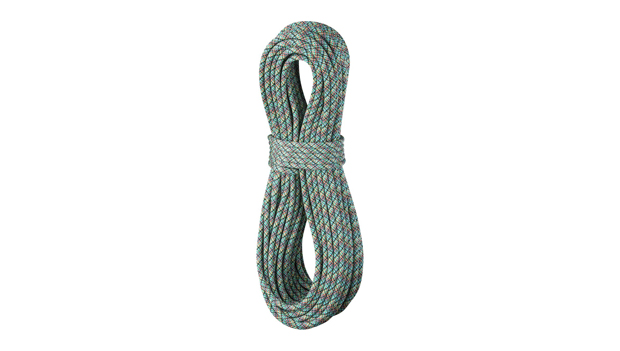
SPECS
- Rope type: Single
- Diameter: 9.8 mm
- Length: 40m, 60m, or 70m
- Dry treatment: Non-dry
- Static elongation: 9.3%
- Dynamic elongation: 32%
- Weight: 62g per meter
- UIAA Falls: 7
- Key features: Bluesign® approved, high-quality left-over yarn for a more sustainable rope, middle mark
The BOA Eco was one of the first ropes on the market to use leftover yarns from other rope manufacturing for a more eco-friendly approach to climbing ropes. The brand uses a heat treatment to bind the yarns together which ensures the rope is just as strong as any other single rope. The rope is supple and easy to handle from the start, and provides a comfortable, springy catch for falls. This is especially great for climbers who want a rope that functions as a daily grinder or all-arounder.
One note: This rope does not have a dry-treatment, so it's best for your standard everyday climbs or single-pitch crag days.
PROS
- Sustainable yarn usage
- Good UIAA fall rating
- Easy belay handling
- Unique rope colors
- Soft catch
- Durable
CONS
- Slightly more expensive than some comparable non-dry ropes
- Shows dirt easily
BUY: Edelrid BOA Eco Climbing Rope 9.8mm
Best Ice and Alpine Rope - Petzl Arial Dry Climbing Rope 9.5mm
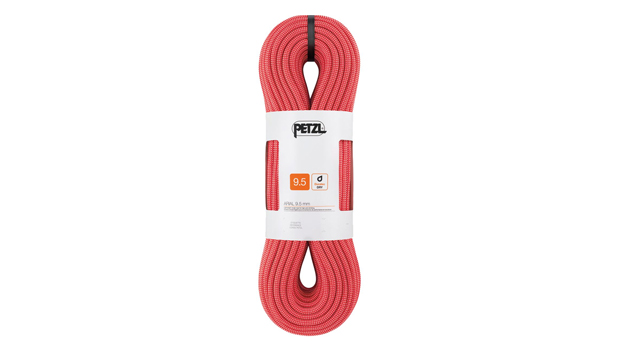
SPECS
- Rope type: Single
- Diameter: 9.5 mm
- Length: 60m, 70m, or 80m
- Dry treatment: Yes, Duratec Dry Treatment
- Static elongation: 7.6%
- Dynamic elongation: 32%
- Weight: 58g per meter
- UIAA Falls: 7
- Key features: Lightweight, EverFlex treatment for easy handling and grip, middle mark
This rope is a favorite for alpine and ice climbing. The light weight and dry treatment make it ideal for adventures with snow, ice or rain and also when you need to carry the rope a long distance. That being said, it's no slouch for lead climbing and all-around climbing either. Many climbers love how smooth the rope feels in a belay device and how easy it is to handle. With a fall rating of 7, it holds up to falls just as well as thicker ropes. But it doesn't have the added weight which is a big plus.
On the other hand, the thinner diameter naturally makes this rope slightly less durable than a thicker rope, so it wouldn't be the ideal rope for regular gym use or top-roping outdoors.
PROS
- Dry treatment
- Lightweight
- Bright colors for high visibility
- Coiled ready to climb at the start
CONS
- Not as durable as a thicker rope
- Higher price point
BUY: Petzl Arial Dry Climbing Rope 9.5mm
Best Beginner Climbing Rope - Black Diamond Rope 9.9mm
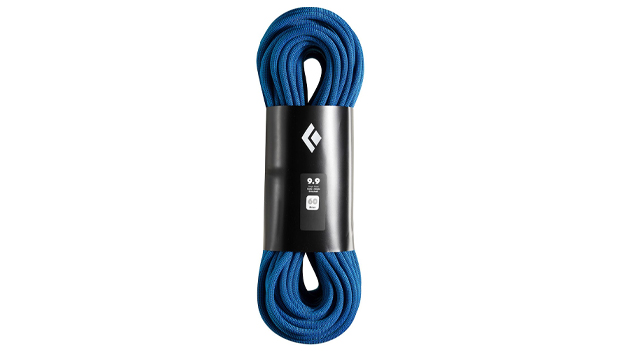
SPECS
- Rope type: Single
- Diameter: 9.9 mm
- Length: 40m, 60m, or 70m
- Dry treatment: Non-dry
- Static elongation: 7.6%
- Dynamic elongation: 32%
- Weight: 64g per meter
- UIAA Falls: 6
- Key features: Easy to handle, good transition from gym to rock, middle mark
This sturdy Black Diamond rope expertly bridges the gap between indoor gym use and outdoor sport climbing. The thicker diameter makes the rope durable enough to take a beating running laps at the gym, but it's not so thick that it feels unwieldy hiking out to the crag.
As a non-dry rope, it picks up dirt fairly quickly in dusty conditions, so it's especially important to have a tarp or rope bag when climbing outside. This rope also has a slightly lower fall rating than others, but it’s still ideal for beginner climbers who are just starting out in the sport.
PROS
- Durable
- Easy to handle for beginners
- Good middle mark
- Budget-friendly
CONS
- Heavy
- At little stiff at first
- No dry treatment
Best Sport-Climbing Rope - Beal Booster III 9.7mm Dry Rope
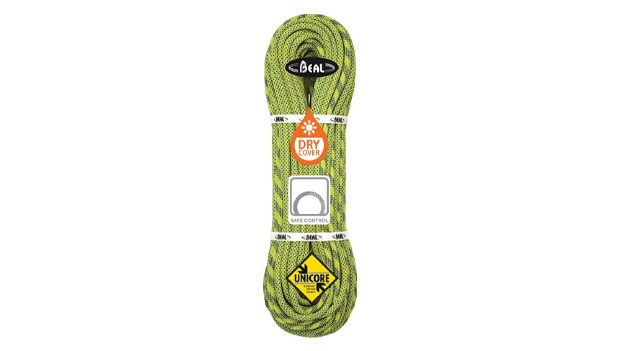
SPECS
- Rope type: Single
- Diameter: 9.7 mm
- Length: 60m or 70m
- Dry treatment: Dry Sheath
- Static elongation: 9.7%
- Dynamic elongation: 38%
- Weight: 61g per meter
- UIAA Falls: 8
- Key features: Bi-pattern option for the 70m, low-impact force, high fall rating
This climbing rope is at the top of the pack for its comfortable, soft catch, ideal for a sport or traditional climb. The impact force for this rope is only 7.3 kN which, in comparison, is at least a full 1 kN less than any other rope on this list. In the grand scheme of things, we wouldn't say this is a complete deciding factor because all the ropes are well below a dangerous level of impact force, but it might be worth considering.
With a soft catch from 38-percent dynamic elongation and the higher fall rating, this would be a great rope for going after hard lead climbs (both sport and trad). The catch? The rope also has a significantly higher static elongation, meaning top roping or hauling gear on this rope would not be as efficient as it would be with other less stretchy ropes.
PROS
- High fall rating
- Dry treatment options
- Low-impact force
- Soft catches
CONS
- Stretchy for top roping
- Expensive
BUY: Beal Booster III 9.7mm Dry Rope
Best Budget Climbing Rope - Mammut Crag Classic Rope 9.5mm
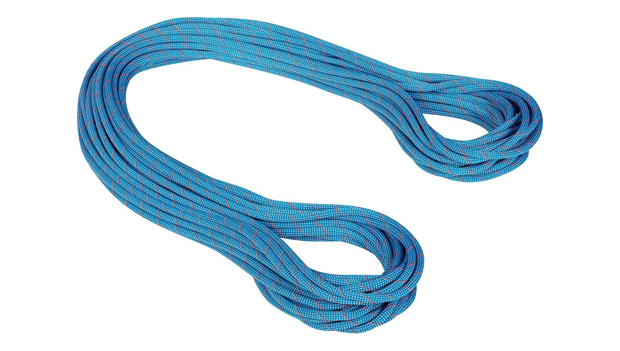
SPECS
- Rope type: Single
- Diameter: 9.5 mm
- Length: 60m, 70m, or 80m
- Dry treatment: Non-dry
- Static elongation: 8.8%
- Dynamic elongation: 33%
- Weight: 59g per meter
- UIAA Falls: 6-7
- Key features: Bluesign® approved, bi-patterned option
Purchasing a climbing rope doesn’t have to cost you an arm and a leg. Along with being a great all-arounder climbing rope, the Mammut Crag Classic Rope is also one of the most affordable. This rope comes with a wide range of options of lengths, dry treatments, bi-patterned, and even a more sustainable option with leftover yarns.
It’s also an excellent option for a first rope because it's easy to handle right from the start and is relatively affordable. However, it's equally good for the experienced climber looking for a solid everyday rope that can cover most of the bases. The only instances you wouldn't want to take this rope is when ice climbing or during long alpine routes where you might get rain or snow because the standard Crag Classic doesn't have a dry treatment.
PROS
- Price
- Bluesign® approved
- Easy to handle
- Durable
CONS
- Weight
- Lower fall rating
BUY: Mammut Crag Classic Rope 9.5mm
Best Indoor Climbing Rope - Mammut Gym Workhorse Classic Rope 9.9mm

SPECS
- Rope type: Single
- Diameter: 9.9 mm
- Length: 40m
- Dry treatment: Non-dry
- Static elongation: 8.3%
- Dynamic elongation: 33.5%
- Weight: 65g per meter
- UIAA Falls: 8-9
- Key features: Shorter for gym climbing, high fall rating
For indoor climbing, you generally don't need as long of a rope because the routes aren't as long. Some gyms have higher walls, so you'll want to double check with your gym, but for the most part, most gyms don't need a rope longer than 40 meters. In these cases, bringing a 60-meter rope to the gym just adds extra work for you to coil and manage the rope.
Enter the 40-meter Mammut Gym Workhorse. This beast of a rope is chunky with a 9.9 millimeter diameter, meaning it can take a beating on top rope and regular runs at the gym. The thicker, heavier rope wouldn't be ideal for outdoor climbing, but you'd be hard pressed to find a better rope for the gym. The rope also offers a soft catch and easy handling at an affordable price.
PROS
- Price
- High UIAA Fall rating
- Durable
CONS
- Heavy
- Non-dry
- Shorter length
BUY: Mammut Gym Workhorse Classic Rope 9.9mm
FAQs About Climbing Ropes
What rope is best for climbing?
The best climbing rope for you really depends on your experience level and what you hope to accomplish with your climbs. All of the options on are list are great choices, but remember the right climbing rope for you will likely differ from the right one for someone else based on personal preferences, budget, and climbing needs.
What is a dynamic rope vs. a static rope?
A dynamic rope is a rope that has more elasticity, which helps it absorb impact from falls. All lead or top rope climbing ropes are dynamic ropes.
Static ropes don’t have this level of impact absorption and would not be able to safely or comfortably catch a fall. Static ropes are more for fixed lines, lowering an injured climber, or pulling up gear.
How thick should a rope be to climb?
Single ropes can range anywhere from 8.8 millimeters to 10.2 millimeters, but for all-around climbing, the best thickness is between 9.4 and 9.9 millimeters in diameter.


